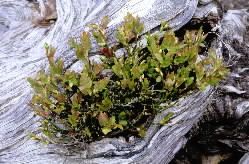Summary

Vaccinium myrtillus is an indicator species of acidic soils
Ground vegetation community structure and composition are good bio-indicators of site fertility and environmental change. A growing body of evidence indicates that the composition of ground flora in British woodland has been altered through the deposition of nitrogen compounds (Kirby et al., 2005).
Ground vegetation surveys are carried out at three-yearly intervals at the Intensive Forest Monitoring sites, and their environmental requirements assessed according to Ellenberg*. These assessments have been used to identify whether there have been any significant short- and long-term floristic changes in response to pollution management, or other environmental influences.
Analysis of the Alice Holt site reveals that the composition of understorey vegetation is highly resistant to short-term changes in climatic conditions (e.g. drought, frost). In contrast, the impacts of management are generally more dramatic and long-lasting, with increasing numbers of ruderal and light-requiring plants emerging following thinning.
As an example, at the Thetford Level II site, an increase in ‘Ellenberg’ indicators of nitrogen and pH indicate a response of the ground vegetation to increased nitrogen from atmospheric deposition or to canopy opening and release of nitrogen through the decomposition of brash left on site. This highlights the point that excess nitrogen is affecting the wider ecosystem, indicating an underlying pressure that may affect tree health and growth in the future. The fall seen in 2019 can be attributed to the severe drought experienced at the site in 2018 leading to a (>50%) reduction in the number of grasses and herbs found in the 2019 survey.
The Intensive Forest Monitoring sites are helping to build up a picture of how biodiversity is affected by forest management and its interaction with the environment. This will be valuable in developing guidance for better informed conservation management of forests.
* Ellenberg values are used to interpret plant distribution in terms of environmental factors. Ellenberg defined seven scales, each representing a particular environmental factor, but four scales used by Hill et al. (1999), i.e. Light, Moisture, Reaction (pH) and Nitrogen, have been adopted in forest ecological research in Britain.
References
Hill, M.O., Mountford, J.O., Roy, D.B. and Bunce, R.G.H. (1999). Ellenberg’s indicator values for British plants. ECOFACT Volume 2 Technical Annex. ITE, Huntingdon.
Kirby, K.J., Smart, S.M., Black, H.I.J., Bunce, R.G.H., Corney, P.M. and Smithers, R.J. (2005). Long term ecological change in British woodland (1971–2001). A re-survey and analysis of change based on 103 sites in the Nature Conservancy ‘Bunce 1971’ woodland survey. English Nature Research Report number 653. English Nature, Peterborough.
